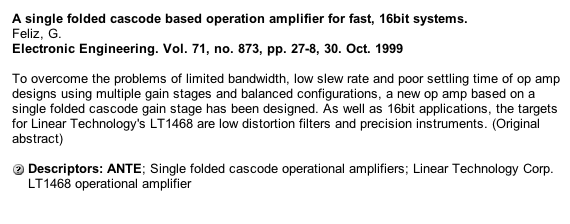Thanks for the discussion so far.
I suppose you might try getting a preprint from LT, particularly if the author still works there.
I contacted the publisher; if that doesn't work out I'll try to contact LT but the website doesn't offer an obvious way for such requests.
Heres some copy from their website.
That last ref has got to be about all of what the guy says in the Electronic Engineering journal paper.
Seen those--was hoping to get a more detailed schematic in the article, but it's probably the wrong journal for that. LT seems not to be particulary keen on publishing IEEE papers, what a pity.
I think this is just pretty much an AD797 upside down, isn't it?
It is, there are some differences though. The current mirror is more elaborate in the AD797 (if we assume that the available LT1468 schematic is not that much simplified), the output stage is different in the details and there's no distortion cancellation capacitor.
I wonder (a) ADI got the patent claims they asked for with the 797, and (b) if so, they sued LT.
Bootstrapping a current-mirror was done earlier, e.g. for the
LM108.pdf. Not the same overall topology, but nonetheless relatively close. The distortion cancellation capacitor which is covered in the patent as well must be new though, never seen that anywhere else.
I've been real happy with the LT1468 in some high end audio apps.
Indeed one of the best audio opamps out there nowadays. Just a pitty that they run the input stage at that low current, makes the OSI somewhat highish for typical audio apps. And there is steeply (faster than usual) rising common-mode distortion above 10 kHz; probably a result of the not bootstrapped current bias cancellation circuitry.
I haven't had time to compare against the new National super-whizz-bangs though.
According to my measurements it is pretty similar in performance to the LME49860. The AD797 still beats these two though.
It looks like there's something funky going on around 10 MHz. Is this something to be concerned about?
No. They roll-off gain in the MHz region in order to get more GBW up to 1 MHz or so, resulting in some phase "wobbling". Almost every higher-speed opamp does this (even the NE5534 did that years back and still does), and it improves performance significantly. For certain gain configuration there will be some increased peaking and overshoot, but this is easily handled by the addition of a feedback capacitor (which is anyway good design practice for audio).
Samuel



































